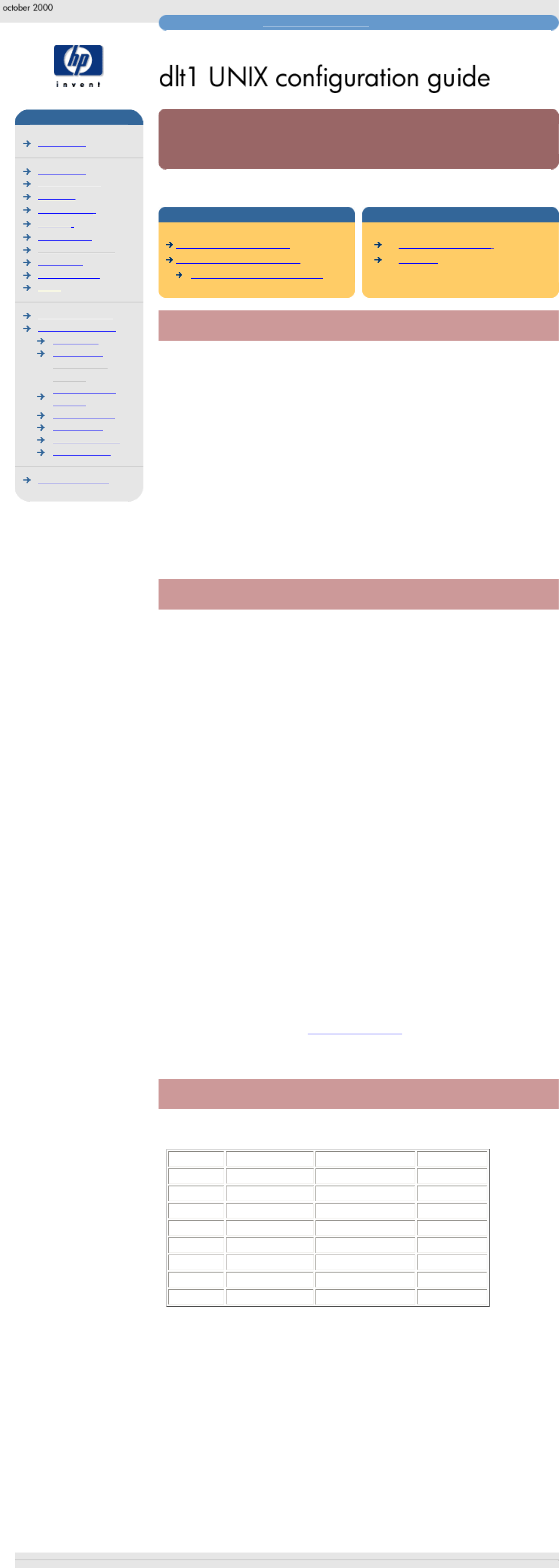
UNIX ibm
hp learning products
http://www.hp.com/support/tape may have a later version
data protection
contact hp
home page
before you start
operation
cartridge care
cleaning
specifications
media compatibility
diagnostics
troubleshooting
FAQs
SCSI configuration
UNIX configuration
hp systems
dec systems
ibm RS/6000
systems
pc based UNIX
systems
silicon graphics
sun systems
verify installation
UNIX glossary
ordering supplies
IBM RS/600 systems, AIX
This topic is available in English only.
contents of this section
determining the SCSI ID
configuring the device files
device file names under AIX
related topics
verifying installation
glossary
determining the SCSI id
Before you configure your system to support your new HP Surestore DLT1 drive,
you need to determine what SCSI ID to use. The SCSI ID must be unique for each
device attached to the SCSI bus. To list the existing devices, use the following
command:
% lsdev -C |grep SCSI
This will produce output that looks similar to:
scsi0 Available 00-00-0S Standard SCSI I/O Controller
hdisk0 Available 00-00-0S-0 1.0 GB SCSI Disk Drive
rmt1 Defined 00-00-0S-2,0 Other SCSI Tape Drive
The SCSI ID is in the series 00-00-0S-X,0 where X is the SCSI ID. Review the list
of existing SCSI IDs and choose an available ID to assign to your new tape drive.
configuring the device files
To install the HP Surestore DLT1 drive on an IBM workstation running AIX, you will
need to create the appropriate device files for the drive.
NOTE: Do not choose the smit option of "4mm2gb" as the Tape Device Type. This
is reserved for Connor drives. If you use it with HP drives, you will get the error
"Device to be configured does not match the physical device
at the specified connection location".
To change to variable block mode, use the following procedure:
1
If you are using a graphics terminal running X-Windows, then at a Windows
terminal, type: smit tape
If you are using a non-graphics terminal, at the command line type:
% smit -C tape
2
If no device has been configured at this address before, select "add a
tape drive" to set up the address. From the pop-up window, select "ost"
or "Other SCSI tape drive" as the tape drive you wish to change and
choose connection addresses as appropriate.
3
Select from the window: "change/show characteristics of a tape
drive"
4
From the pop-up window, select "ost" or "Other SCSI tape drive" as
the tape drive you wish to change. Do not choose "4mm2gb".
5
Change the block size field to 0, and click on the "DO" button or press [Enter]
to apply the change.
HP DLT1 drives will work with tar, cpio, backup, restore and dd. For systems
other than the 43P, the drive is also boot-capable, provided a boot tape is
generated using mkszfile and mksysb.
Once the device files have been created, you should confirm that your new tape
drive is working properly. See Verifying Installation.
device file names under AIX
Use device filenames as listed below for the combination of Rewind on Close,
Retension on Open, and Compression that you want:
Filename Rewind on Close Retension on Open Compression
/dev/rmtn
Yes No enabled
/dev/rmtn.1
No No enabled
/dev/rmtn.2
Yes Yes enabled
/dev/rmtn.3
No Yes enabled
/dev/rmtn.4
Yes No disabled
/dev/rmtn.5
No No disabled
/dev/rmtn.6
Yes Yes disabled
/dev/rmtn.7
No Yes disabled
The n in the filename is the instance number assigned to the drive by the
operating system, where 0 is the first device, 1 is the second and so on.
Rewind on Close
Normally, the drive repositions the tape to BOT (Beginning
of Tape) when the device file is closed. Using the no rewind
option is useful when creating and reading tapes that
contain multiple files.
Retension on Open
Retensioning consists of winding to EOT (End of Tape) and
then rewinding to BOT, in order to reduce errors. If this
option is selected, the tape is positioned at BOT as part of
the open process. DLT1 drives do not require retensioning,
so you should not use device fields that send retensioning
commands.
Compression
Compression can be disabled or enabled.
© 2000, Hewlett-Packard Company
file:///C|/Documents%20and%20Settings/topher.COL-SPRINGS/Desktop/manual/document/dlt1/user/reseller/eng/c_ibm.htm [12/3/2001 7:50:49 AM]


















